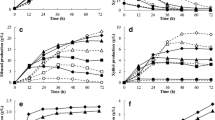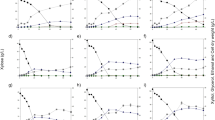Abstract
Xylulose fermentation by four strains of Saccharomyces cerevisiae and two strains of xylose-fermenting yeasts, Pichia stipitis CBS 6054 and Candida shehatae NJ 23, was compared using a mineral medium at a cell concentration of 10 g (dry weight)/l. When xylulose was the sole carbon source and fermentation was anaerobic, S. cerevisiae ATCC 24860 and CBS 8066 showed a substrate consumption rate of 0.035 g g cells−1 h−1 compared with 0.833 g g cells−1 h−1 for glucose. Bakers' yeast and S. cerevisiae isolate 3 consumed xylulose at a much lower rate although they fermented glucose as rapidly as the ATCC and the CBS strains. While P. stipitis CBS 6054 consumed both xylulose and glucose very slowly under anaerobic conditions, C. shehatae NJ 23 fermented xylulose at a rate of 0.345 g g cells−1 h−1, compared with 0.575 g g cells−1 h−1 for glucose. For all six strains, the addition of glucose to the xylulose medium did not enhance the consumption of xylulose, but increased the cell biomass concentrations. When fermentation was performed under oxygen-limited conditions, less xylulose was consumed by S. cerevisiae ATCC 24860 and C. shehatae NJ 23, and 50%–65% of the assimilated carbon could not be accounted for in the products determined.
Similar content being viewed by others
References
Chiang L-C, Gong C-S, Chen L-F, Tsao GT (1981) d-Xylulose fermentation to ethanol by Saccharomyces cerevisiae. Appl Environ Microbiol 42:284–289
Dijken JP van, Scheffers WA (1986) Redox balances in the metabolism of sugars by yeasts. FEMS Microbiol Rev 32:199–224
Gong C-S, Chen L-F, Flickinger MC, Chiang L-C, Tsao GT (1981) Production of ethanol from d-xylose by using d-xylose isomerase and yeast. Appl Environ Microbiol 41:430–436
Hahn-Hägerdal B, Berner S, Skoog K (1986) Improved ethanol production from xylose with glucose isomerase and Saccharomyces cerevisiae using the respiratory inhibitor azide. Appl Microbiol Biotechnol 24:287–293
Hahn-Hägerdal B, Jeppsson H, Skoog K, Prior BA (1994) Biochemistry and physiology of xylose fermentation by yeasts. Enzyme Microb Technol 16:933–943
Hinman ND, Wright JD, Hoagland W, Wyman CE (1989) Xylose fermentation — An economic analysis. Appl Biochem Biotechnol 20/21:391–401
Jeffries TW, Kurtzman CP (1994) Strain selection, taxonomy, and genetics of xylose-fermenting yeasts. Enzyme Microb Technol 16:922–932
Kötter P, Ciriacy M (1993) Xylose fermentation by Saccharomyces cerevisiae. Appl Microbiol Biotechnol 38:776–783
Lindén T, Hahn-Hägerdal B (1989) HPLC determination of xylulose formed by enzymatic xylose isomerization in lignocellulose hydrolysates. Biotechnol Tech 3:189–192
Lindén T, Peetre J, Hahn-Hägerdal B (1992) Isolation and characterization of acetic acid-tolerant galactose-fermenting strains of Saccharomyces cerevisiae from a spent sulfite liquor fermentation plant. Appl Environ Microbiol 58:1661–1669
Meinander N, Hallborn J, Keränen S, Ojamo H, Penttilä M, Walfridsson M, Hahn-Hägerdal B (1994) Utilization of xylose with recombinant Saccharomyces cerevisiae harbouring genes for xylose metabolism from Pichia stipitis. In: Alberghina L, Frontali L, Sensi P (eds) Proceedings of 6th European Congress of Biotechnology. Elsevier Science, Amsterdam, pp 1143–1146
Olsson L, Lindén T, Hahn-Hägerdal B (1994) A rapid chromatographic method for the production of preparative amounts of xylulose. Enzyme Microb Technol 16:388–394
Roels JA (1983) Energetic and kinetics in biotechnology. Elsevier Biomedical, Amsterdam pp 23–69
Senac T, Hahn-Hägerdal B (1990) Intermediary metabolite concentrations in xylulose- and glucose-fermenting Saccharomyces cerevisiae cells. Appl Environ Microbiol 56:120–126
Skoog K, Hahn-Hägerdal B (1990) Effect of oxygenation on xylose fermentation by Pichia stipitis. Appl Environ Microbiol 56:3389–3394
Skoog K, Jeppsson H, Hahn-Hägerdal B (1992) The effect of oxygenation on glucose fermentation with Pichia stipitis. Appl Biochem Biotechnol 34/35:369–375
Tantirungkij M, Nakashima N, Seki T, Yoshida T (1993) Construction of xylose-assimilating Saccharomyces cerevisiae. J Ferment Bioeng 75:83–88
Ueng PP, Hunter CA, Gong C-S, Tsao GT (1981) d-Xylulose fermentation in yeasts. Biotechnol Lett 3:315–320
Verduyn C, Postma E, Scheffers WA, Dijken JP van (1992) Effect of benzoic acid on metabolic fluxes in yeasts: a continuous-culture study on the regulation of respiration and alcoholic fermentation. Yeast 8:501–517
Wang PY, Schneider H (1980) Growth of yeasts on d-xylulose. Can J Microbiol 26:1165–1168
Yu S, Wayman M, Parekh SK (1987) Fermentation to ethanol of pentose-containing spent sulphite liquor. Biotechnol Bioeng 29:1144–1150
Author information
Authors and Affiliations
Rights and permissions
About this article
Cite this article
Yu, S., Jeppsson, H. & Hahn-Hägerdal, B. Xylulose fermentation by Saccharomyces cerevisiae and xylose-fermenting yeast strains. Appl Microbiol Biotechnol 44, 314–320 (1995). https://doi.org/10.1007/BF00169922
Received:
Revised:
Accepted:
Issue Date:
DOI: https://doi.org/10.1007/BF00169922




